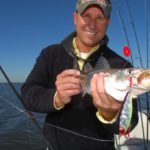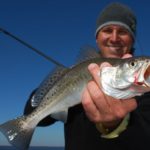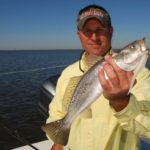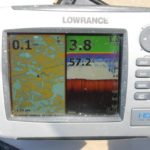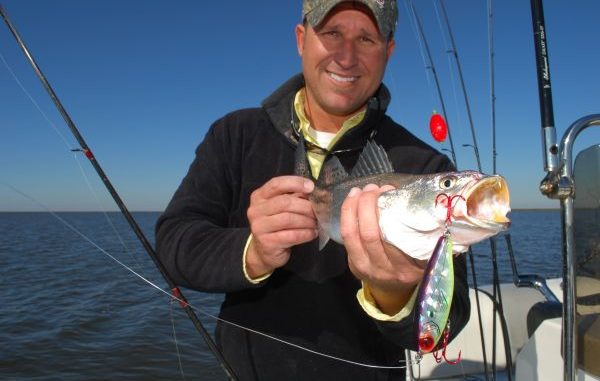
Learn why this accomplished St. Bernard Parish guide uses a cork with almost religious fervor to put trout in the boat day after day.
Scrunch, Scrunch, Schrunch! The heavy frost on the vehicle’s windshield wasn’t yielding easily to my efforts.
“Man, it’s cold. What am I doing going trout fishing?” I asked myself. The day before, young-gun guide Kerry Audibert Jr. told me that he needed fish (read speckled trout) for his freezer.
“I don’t have a fish put up. My clients keep all the fish,” he laughed. “I don’t have time to fish. I have become their deck hand.” He also told me that he loves to fish with a cork. In fact, he said that when he fishes for speckled trout, he uses a cork 80 percent of the time. So I was expecting a lesson in cork fishing today.
Still — ”It was cold!
At the Breton Sound Marina in Hopedale, croaky-voiced but friendly Islenõ Glen Sanchez greeted Audibert. The sun was well up. Duck hunters were returning to the landing and fishermen were going out.
“I don’t leave before daylight this time of year,” explained Audibert. “It’s too durn cold.”
A brilliant sun was beginning to knock the chill off the air. Cobalt blue may be the most overused sky description, but there really wasn’t another word to do this sky justice.
Audibert didn’t seem to carry a sense of urgency, in spite of the relatively late hour. His run from Bayou la Loutre, down the pipeline canal to Lake Robin can only be described as leisurely.
In the lake, he stopped to make a few casts using a live shrimp hooked under the horn. His terminal rig, indeed, included a cork set above a 1 ½-foot fluorocarbon leader. He didn’t get a look.
From there it was to Bay Batola at Bayou Batola. Here he tossed a lemon-drop Edge Hybrid Flurry soft plastic on a jighead, again under a cork. It was an odd-looking color, kind of glow with a chartreuse back. It didn’t matter, though. He didn’t get a bump, in spite of working the cork hard, with strong jerks from his rod.
I glanced at my watch. It was 8:30 a.m. and we didn’t have a fish. He caught me in the act and chuckled.
“It’s still early,” Audibert said. “The fish really won’t bite until 10 o’clock.”
He cranked the big motor and eased into Bayou Batola to drift with the wind. His boat wasn’t rigged with a trolling motor.
Now he was chunking a purple/chartreuse Flurry, what some anglers would call “LSU color.”
From there, it was back through Lake Robin into the mouth of Bayou Robin, again drifting and casting. And catching nothing!
Then on to a pass between two ponds near Lake Ameda. He alternated between casting his plastic-tipped jigs tight-lined and under a cork.
It had been all plastics since the first stop.
“I feel that I can fish faster and find them with artificials,” he explained. “I move until a find a few, and then I will work on them.”
Finally, where the west end of Lake Ameda breaks into a straight pipeline canal, the cork on a line that he had just rigged with a live shrimp went down. He missed it and then got two more sluggish bites.
Neither produces a hook-up.
Trying to entice the fish, he alternated between throwing plastic under a cork and live shrimp under a cork. Then he tried both at once; He stuck one rod, usually the one with live bait between his legs, and worked the other one. He kept swapping rods.
It was comical. But it didn’t help.
We moved again.
“I was named Etch A Sketch by Stan Cuquet, another fishing guide out of the marina,” Audibert grinned. “Barry Brechtel, the marina owner, took the name and ran with it. It was a long day, and I had to cover a lot of territory to find them. He said, ˜Man, your GPS must look like an Etch A Sketch.’
“It has become a verb too. Other guides from the marina say ˜I Etch A Sketched it today.'”
I glanced at my watch apprehensively. It was well after 10 a.m., his predicted bewitching hour.
Next stop was a small opening between Oak River and a large pond, about a half mile west of Adema Pond. It looked like any other of a thousand such openings into ponds.
The pond was shallow, we learn after fishing it, ”about 2 ½ feet deep. The short channel between it and Oak River was 5 feet deep.
A cast well into the cut with a live shrimp produced a nice speck on the very end of the cast. The next cast caught his twin. Audibert switched to his purple/chartreuse Flurrys and caught three more, all at the very end of the cast.
He allowed the boat to drift into the cut to make reaching the magic spot easier, and then planted his PVC spud pole.
He began to wear them out. There wasn’t any measuring. They were all easily legal-sized, and they were all ultra-willing.
Whether it was the cork alone that turned them on, we will never know, but turned on they were!
Something else happened, as well. I had been watching the temperature reading on his split screen GPS. The whole morning before 10 a.m., it showed water temperatures that were below 55 degrees. By the time he reached the mouth of the cut, it read 55.0 degrees.
By the time he finishes his limit, at 11:46 a.m., it showed 57.2 degrees — 2.2 degrees warmer.
“That isn’t a lot in your world,” Audibert said emphatically, “but it’s a lot in a fish’s world!”
With a limit stowed, ready to head for his knife and his freezer, Audibert began to have real fun. It was catch-and-release time!
He dug in his tackle and came up with a 5-inch MirrOlure Provoker pearl straight tail. It was an ugly piece of plastic, but it caught as well as Hybrid Flurry and the live shrimp did.
He got bored and whipped out a hard lure — a Chartreuse Catch 5, a suspending twitch bait, also by MirrOlure.
They hammered the daylights out of it.
Finally, as if to challenge them, he tied on a pink Corky Devil, also a suspending bait.
“I caught them on this last year at Breton Island,” he murmured to himself.
That one worked, too — every cast.
It had lost its challenge. As he reeled in his last one, he turned and flashed a smug smile.
“I told you it was going to be a late-day bite,” he said.
He did, and he also told me that he was going to turn them on with a cork. He did that too — in spades.
Kerry Audibert Jr. is a featured angler in the book “Trout Masters Too: How the Pros Do It” available on the Sportsman Outdoor Store, on Amazon and for the Kindle. In the book, he and 12 other professional anglers share the techniques that they use to catch speckled trout, especially trophy trout. Ought To Be Fishing Charters, Audibert’s guiding service, can be reached at 504-259-5304.
